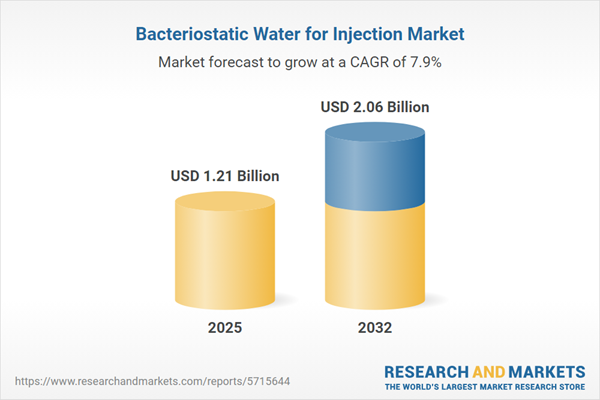Speak directly to the analyst to clarify any post sales queries you may have.
Bacteriostatic water for injection is a critical enabler in pharmaceutical and healthcare delivery chains, supporting the safe reconstitution and administration of injectable treatments. For senior decision-makers, understanding this sector’s evolving market drivers is essential to building robust supply strategies, maintaining compliance, and ensuring uninterrupted operations in a shifting global landscape.
Market Snapshot: Bacteriostatic Water for Injection
The global bacteriostatic water for injection market continues to show stable expansion, with growth largely influenced by increased investment from leading pharmaceutical companies and the increased use of injectable biologics. Regulatory developments and operational priorities are reshaping how businesses manage sourcing and distribution. Adoption of digital solutions within supply networks is optimizing transparency and distribution oversight, while suppliers and distributors face the need to align strategies with varied regulatory environments across markets. Enhanced focus on supply chain control and compliance is prompting both established manufacturers and new entrants to adjust their approaches to procurement and logistical planning.
Bacteriostatic Water for Injection: Scope & Segmentation
- End Users: Hospitals, ambulatory care centers, clinics, diagnostic laboratories, and home care providers use bacteriostatic water to fulfill needs for urgent interventions and ongoing therapies, helping to ensure continuous patient care and operational continuity.
- Packaging Types: Multi-dose vials simplify inventory management in high-traffic settings, while single-dose options support sterility protocols critical for outpatient and remote care environments.
- Applications: Utilized in drug preparation, intravenous therapy, ophthalmic procedures, and laboratory diagnostics, bacteriostatic water underpins precision and consistency in diverse healthcare and research scenarios.
- Distribution Channels: Hospital procurement departments, pharmacy networks, and digital commerce platforms serve as main distribution avenues, ensuring reliable access while supporting regulatory compliance.
- Container Materials: Glass containers maintain sterility for sensitive drug applications, whereas plastics offer logistical benefits and can contribute to sustainability objectives within healthcare operations.
- Volume Variants: Available in 2, 10, and 20 milliliter formats, providing adaptability to use-case requirements, waste minimization, and operational flexibility for end users.
- Geographies Covered: The Americas, Europe, Asia-Pacific, and Middle East & Africa each pose unique regulatory demands and sourcing conditions, shaping market development and enterprise strategies.
- Leading Organizations: Global benchmarks and sector innovation are set by Baxter International Inc., B. Braun Melsungen AG, Fresenius Kabi AG, Pfizer Inc., Steris Plc, Teva Pharmaceutical Industries Ltd., Hikma Pharmaceuticals PLC, Perrigo Company plc, Viatris Inc., and Novartis AG.
Key Takeaways
- Innovative preservative systems are enabling manufacturers and healthcare providers to adapt effectively to regulatory changes and heightened operational requirements.
- Digital traceability integration is driving improvements in supply chain transparency, facilitating early risk detection and prompt management throughout distribution networks.
- Procurement teams are prioritizing reliable sourcing strategies to maintain product quality and availability amidst growing demands for injectable diluents.
- Advances in plastic vial technology are supporting enhanced handling safety and logistics adaptability, addressing global variation in healthcare infrastructure.
- Supplier-healthcare collaborations are pivotal in fortifying supply chain continuity and improving operational resilience in response to fluctuations in demand and market conditions.
- Ongoing preservation system enhancements are maintaining product compliance with global safety standards, ensuring relevance for diverse market environments.
Tariff Impact: 2025 Policy Shifts and Industry Strategies
Upcoming trade policy revisions are influencing raw material costs for preservatives and packaging in the bacteriostatic water for injection sector. Manufacturers are expanding supplier partnerships, strengthening regional collaborations, and exploring formulation alternatives to address price volatility. Emphasis is placed on adaptive procurement measures, digital innovation, and increased regulatory engagement to support consistent production and supply chain stability.
Market Intelligence: Methodology & Data Sources
This market analysis integrates insights from expert stakeholder interviews, scientific literature, active regulatory monitoring, and exclusive proprietary datasets. Scenario modeling supports actionable recommendations for strategic and operational decision-making by senior leadership.
Why This Report Matters
- Comprehensive segmentation and regulatory analysis guide suppliers and buyers in designing resilient, compliant logistics strategies aligned with evolving requirements.
- Benchmarking of packaging and distribution practices aids in detecting market opportunities and ensuring continuity in complex healthcare environments.
- Decision-makers gain targeted intelligence to refine procurement, strengthen risk mitigation, and foster sustainable, adaptable business strategies.
Conclusion
Bacteriostatic water for injection remains essential for healthcare consistency and operational assurance. Targeted market intelligence empowers senior leaders to shape forward-looking, compliant, and adaptable supply strategies for long-term organizational resilience.
Additional Product Information:
- Purchase of this report includes 1 year online access with quarterly updates.
- This report can be updated on request. Please contact our Customer Experience team using the Ask a Question widget on our website.
Table of Contents
3. Executive Summary
4. Market Overview
7. Cumulative Impact of Artificial Intelligence 2025
Companies Mentioned
The companies profiled in this Bacteriostatic Water for Injection market report include:- Baxter International Inc.
- B. Braun Melsungen AG
- Fresenius Kabi AG
- Pfizer Inc.
- Steris PLC
- Teva Pharmaceutical Industries Ltd.
- Hikma Pharmaceuticals PLC
- Perrigo Company PLC
- Viatris Inc.
- Novartis AG
Table Information
| Report Attribute | Details |
|---|---|
| No. of Pages | 180 |
| Published | November 2025 |
| Forecast Period | 2025 - 2032 |
| Estimated Market Value ( USD | $ 1.21 Billion |
| Forecasted Market Value ( USD | $ 2.06 Billion |
| Compound Annual Growth Rate | 7.8% |
| Regions Covered | Global |
| No. of Companies Mentioned | 11 |









